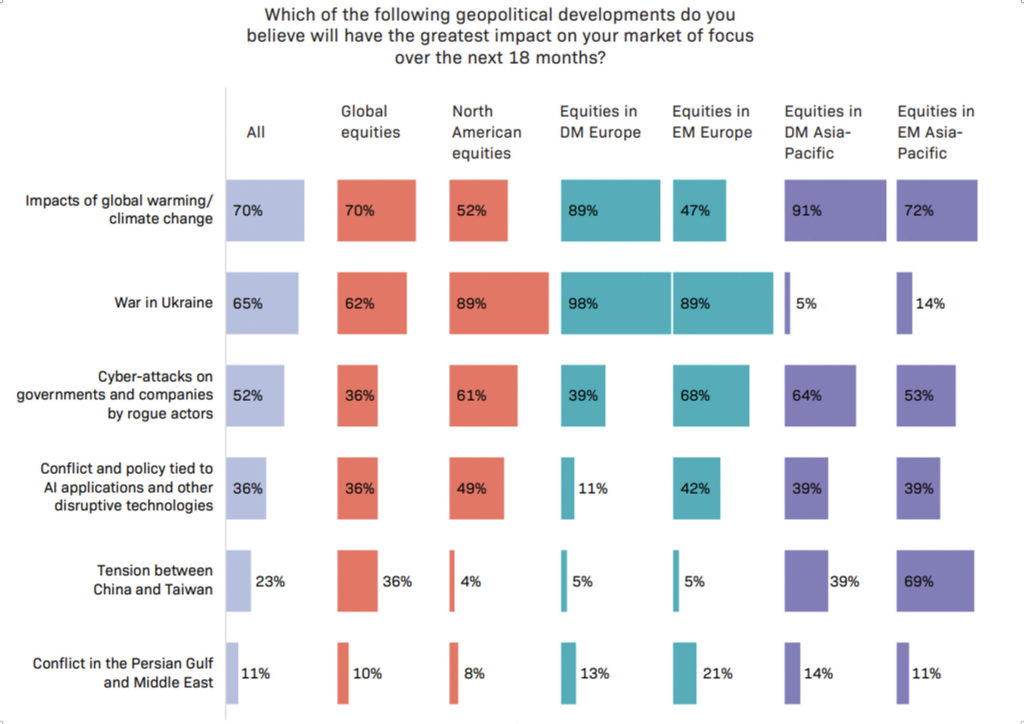Playing defense with cybersecurity stocks
Businesses are woefully underprepared for the increasing frequency and sophistication of cyber-attacks. The total cost of these across the world is expected to reach $10.5 trillion by 2025, more than three times greater than the $3 trillion estimate for 2015 and more than the economic damage done by natural disasters.[1]
Organizations around the world appear to underestimate the problem. Companies spend around $150 billion a year to protect themselves from the cyber menace, but they should be spending closer to $1.5 trillion to $2 trillion to cover all their vulnerabilities, according to consultancy McKinsey.[2]
Meanwhile, insurer Swiss Re believes businesses are only covered for about 10% of the likely losses from cyber-attacks.[3] These include a variety of factors, ranging from direct theft of money, data and intellectual property to service disruption and lost productivity, along with the need to repair and restore compromised systems.
Concerns for equity investors
Investment-decision makers at the world’s major financial institutions are acutely aware of these risks. In an authoritative study on the outlook for global equities, conducted by EquitiesFirst in collaboration with Institutional Investor, a majority of those polled highlighted rogue cyber-attacks on companies and governments as one of the biggest current geopolitical worries, ranking cybersecurity risks just behind climate change and war in Europe.

Image source: https://equitiesfirst.com/int/ii-partnership/
This finding is especially notable for individual investors who may not fully appreciate the true extent of the risks. There are two main reasons why this is often the case.
First, apart from high-profile attacks such as the Colonial Pipeline ransomware attack or massive social media data breaches, we tend not to hear much about them. Yet they are pervasive, with around 2,200 cyber-attacks occurring each day.[4] According to the US Department of Justice, only one in seven cyber-crimes is reported, presumably owing to embarrassment, fear of reputational harm, or the belief that law enforcement will not be able to help.[5]
Second, the impact of data leaks and breaches may not be felt for months or even years after they take place. Chances are, your data has been compromised – consider that recent data breaches of Facebook and LinkedIn compromised well over a half billion accounts each, while the mother of all breaches – suffered by Yahoo in 2013 – compromised 3 billion accounts.[6] The full cost of these breaches will perhaps never be determined.
The risk from cyber-attacks weighs on investors focused on all the markets covered in the study, in North America, Europe and Asia.
Investors focused on North American markets – where the most high-profile cyber-security solutions providers, including CrowdStrike, Palo Alto Networks, Datadog, Okta and Splunk,[7] are listed – are significantly more concerned about cyber-attacks than the global average.
More systemic risks
Along with the rise in cyber-crime affecting businesses and individuals, the World Economic Forum warns that attempts to disrupt critical technology-enabled resources and services will become more common, with attacks anticipated against agriculture and water, financial systems, public security, transport, energy and domestic, space-based and undersea communication infrastructure.[8]
Already, concerted attacks of these sorts have been evident in the Russia-Ukraine war, showing how vulnerable the critical functioning of whole economies have become to cyber-attacks.
Those vulnerabilities are multiplying as a consequence of an ever-expanding “attack surface.”[9] There are now more than three times as many networked devices on earth than there are people,[10] and the number of networked sensors embedded around us is set to balloon from 1 trillion to 45 trillion over the next 15 years.
The cybersecurity landscape is further complicated by continued advances in artificial intelligence, which can be used by both attackers and defenders. Moreover, many fear that the advent of quantum computing – which threatens to destabilize virtually all current encryption systems – could tip the balance towards the attackers in the unending arms race between the two sides.
Riding the defensive wave
Faced with the chilling prospect of cyber criminals gaining the upper hand, and as they become more aware of the risks, businesses are likely to ramp up their spending on cybersecurity considerably in coming years.
This could benefit cybersecurity stocks, which appear to have lagged the overall tech sector so far in 2023.[11] With a recession looming, they may also benefit from their defensive nature, given the need to guard against cyber risks in both good times and bad.
Individuals wishing to access liquidity to either invest in cybersecurity stocks or shore up their own cyber defenses could consider securities-backed financing. By using their equity or crypto as collateral, they can obtain non-recourse, non-purpose capital at competitive terms, while retaining all beneficial ownership and upside from the underlying assets upon completion of the financing term.
It is always wise to have a good defense. But given the heightened uncertainty in equity markets and the scale of the threat posed by cyber crime, investors would do well to be prepared.
[1] https://www.forbes.com/sites/rajindertumber/2019/01/05/cyber-attacks-igniting-the-next-recession/?sh=1c3747eddbe4
[2] https://www.mckinsey.com/capabilities/risk-and-resilience/our-insights/cybersecurity/new-survey-reveals-2-trillion-dollar-market-opportunity-for-cybersecurity-technology-and-service-providers
[3] https://www.swissre.com/institute/research/topics-and-risk-dialogues/digital-business-model-and-cyber-risk/cyber-insurance-strengthening-resilience.html
[4] https://www.cobalt.io/blog/cybersecurity-statistics-2023
[5] https://www.anapaya.net/blog/the-unseen-problem-of-unreported-cybercrime
[6] https://www.csoonline.com/article/2130877/the-biggest-data-breaches-of-the-21st-century.html
[7] https://www.fool.com/investing/stock-market/market-sectors/information-technology/cybersecurity-stocks/
[8] https://www.weforum.org/reports/global-risks-report-2023/digest/
[9] https://www.ibm.com/topics/attack-surface
[10] https://www.cisco.com/c/en/us/solutions/collateral/executive-perspectives/annual-internet-report/white-paper-c11-741490.html
[11] https://www.investors.com/news/technology/cybersecurity-stocks/
إخلاء مسؤولية
أعدت هذه الوثيقة خصيصاً للمستثمرين المعتمدين أو المستثمرين المتطورين ماليًّا أو المستثمرين المحترفين أو المستثمرين المؤهلين، على النحو الذي يقتضيه القانون أو غيره، وهي ليست موجهة للأشخاص الذين لا يستوفون المتطلبات ذات الصلة وينبغي عدم استخدامها من أجلهم. يستخدم محتوى هذه الوثيقة لأغراض إعلامية فقط ويغلب عليه الطابع العام ولا يلبي أي غاية محددة أو حاجة مالية معينة. تخص وجهات النظر والآراء الواردة في هذه الوثيقة أطرافًا ثالثة ولا تعكس بالضرورة وجهات نظر شركة “إيكويتيز فيرست” أو آراءها. لم تفحص شركة “إيكويتيز فيرست” المعلومات الواردة في هذه الوثيقة أو لم تتحقق منها بشكل مستقل، ولا تقدم أي تعهد بمدى دقتها أو اكتمالها. تخضع الآراء والمعلومات الواردة في هذه الوثيقة للتغيير من دون إشعار. لا يمثل محتوى الوثيقة عرضًا لبيع (أو طلب عرض شراء) أي أوراق مالية أو استثمارات أو منتجات مالية (يشار إليها باسم “العرض”). يجب تقديم أي عرض مماثل لذلك فقط من خلال عرض ذي صلة أو وثائق أخرى تحدد شروطه وأحكامه المادية. لا يشكل أي محتوى وارد في هذه الوثيقة توصية أو طلبًا أو دعوة أو إغراء أو ترويجًا أو عرضًا لشراء أو بيع أي منتج استثماري من شركة “إيكويتيز فيرست” أو “إيكويتيز فيرست هولدينجز المحدودة” أو الشركات التابعة لها (يشار إليها مجتمعة باسم “إيكويتيز فيرست”)، ولا يجوز تفسير هذه الوثيقة بأي شكل من الأشكال على أنها مشورة استثمارية أو قانونية أو ضريبية أو توصية أو مرجع أو إقرار مقدم من شركة “إيكويتيز فيرست”. وعليك طلب المشورة المالية المستقلة قبل اتخاذ أي قرار استثماري بشأن منتج مالي معين.
تحتفظ هذه الوثيقة بحقوق الملكية الفكرية لشركة “إيكويتيز فيرست” في الولايات المتحدة ودول أخرى، ويشمل ذلك على سبيل المثال لا الحصر، الشعارات الخاصة بها وغيرها من العلامات التجارية وعلامات الخدمة المسجلة وغير المسجلة. تحتفظ الشركة بجميع الحقوق المتعلقة بملكيتها الفكرية الواردة في هذه الوثيقة. ينبغي لمستلمي هذه الوثيقة عدم توزيعها أو نشرها أو إعادة إنتاجها أو إتاحتها كليًّا أو جزئيًّا بأي شكل من الأشكال لأي شخص آخر، لا سيما الأشخاص في دولة قد يؤدي توزيع هذه الوثيقة فيها إلى خرق أي شرط قانوني أو تنظيمي.
لا تقدم شركة “إيكويتيز فيرست” أي تعهد أو ضمان فيما يتعلق بهذه الوثيقة، وتخلي مسؤوليتها صراحة عن أي ضمان ضمني بموجب القانون. وعليه تقر بأن شركة “إيكويتيز فيرست” ليست مسؤولة تحت أي ظرف من الظروف عن أي أضرار مباشرة أو غير مباشرة أو خاصة أو تبعية أو عرضية أو عقابية أيًّا كان نوعها، منها على سبيل المثال لا الحصر، أي أرباح مفقودة أو فرص ضائعة، حتى إذا تم إخطار الشركة بإمكانية وقوع مثل هذه الأضرار.
تدلي شركة “إيكويتيز فيرست” بالتصريحات الإضافية الآتية التي قد تطبق في دول الاختصاص القضائي المذكورة:
دبي: تخضع شركة “إيكويتيز فيرست هونج كونج المحدودة” (التي يشار إليها باسم “المكتب التمثيلي بمركز دبي المالي العالمي”) الكائنة في مبنى حي البوابة 4، الطابق 6، المكتب 7، مركز دبي المالي العالمي (التي تحمل ترخيصًا تجاريًّا رقم CL7354) للوائح سلطة دبي للخدمات المالية بصفتها مكتبًّا تمثيليًّا (رقم مرجع الشركة لدى سلطة دبي للخدمات المالية:F008752 ). جميع الحقوق محفوظة.
تعد المعلومات الواردة في هذه الوثيقة عامة بطبيعتها، وإذا نُظر إليها على أنها مشورة، فإن أي مشورة واردة هنا عامة وقد تم إعدادها من دون النظر إلى أهدافك أو وضعك المالي أو ملاءمة منتجاتك المالية أو احتياجاتك.
تُستخدم المواد الواردة في هذه الوثيقة لأغراض معلوماتية فقط وينبغي عدم تفسيرها على أنها مشورة مالية أو عرض أو طلب أو توصية لشراء منتجات مالية أو بيعها. تعد المعلومات الواردة في هذه الوثيقة عامة بطبيعتها، وأي مشورة واردة هنا هي عامة وقد تم إعدادها من دون النظر إلى أهدافك أو وضعك المالي أو ملاءمة منتجاتك المالية أو احتياجاتك. لذا قبل استخدام أي من هذه المعلومات، يجب أن تفكر في مدى ملاءمتها لأهدافك ووضعك المالي واحتياجاتك وطبيعة المنتج المالي ذي الصلة. يمكنك استشارة مستشار مالي معتمد إذا لم تكن بعض محتويات هذه الوثيقة واضحة بالنسبة إليك.
تختص هذه الوثيقة بمنتج مالي لا يخضع لأي شكل من أشكال التنظيم أو الاعتماد الخاص بسلطة دبي للخدمات المالية. لا تتحمل سلطة دبي للخدمات المالية أي مسؤولية عن مراجعة أي وثائق تتعلق بهذا المنتج المالي أو التحقق منها. وعليه، لم تعتمد سلطة دبي للخدمات المالية هذه الوثيقة أو أي وثائق أخرى مرتبطة بها ولم تتخذ أي خطوات للتحقق من المعلومات الواردة فيها، ولا تتحمل أي مسؤولية ناجمة عنها.
أستراليا: تحمل شركة “إيكويتيز فيرست هولدينجز (أستراليا) ذات المسؤولية المحدودة” (رقم الشركة في أستراليا: 399 644 142) ترخيصًا لمزاولة الخدمات المالية في أستراليا (رقم الترخيص: 387079). جميع الحقوق محفوظة.
توجه المعلومات الواردة في هذه الوثيقة للأشخاص في أستراليا فقط المصنفين بأنهم عملاء في قطاع التجارة بالجملة على النحو المحدد في القسم 761G من قانون الشركات لعام 2001. قد يُقيد توزيع المعلومات على الأشخاص الذين لا تنطبق عليهم هذه المعايير بموجب القانون، ويجب على الأشخاص الذين يمتلكونها طلب المشورة ومراعاة أي قيود تتعلق بها.
تستخدم المواد الواردة في هذه الوثيقة لأغراض معلوماتية فقط وينبغي عدم تفسيرها على أنها عرض أو طلب أو توصية لشراء منتجات مالية أو بيعها.
تُعد المعلومات الواردة في هذه الوثيقة عامة بطبيعتها وليست مشورة شخصية بشأن المنتجات المالية. أي مشورة واردة في الوثيقة هي عامة فقط وقد تم إعدادها من دون النظر إلى أهدافك أو وضعك المالي أو احتياجاتك. لذا قبل استخدام أي من هذه المعلومات، يجب أن تفكر في مدى ملاءمتها لأهدافك ووضعك المالي واحتياجاتك وطبيعة المنتج المالي ذي الصلة. عليك طلب المشورة المالية المستقلة وقراءة بيانات الإفصاح ذات الصلة أو وثائق العرض الأخرى قبل اتخاذ أي قرار استثماري بشأن منتج مالي معين.
هونغ كونغ: تمتلك شركة “إيكويتيز فيرست هولدينجز هونج كونج المحدودة” ترخيصًا من النوع 1 من لجنة هونغ كونغ للأوراق المالية والعقود الآجلة، وهي مرخصة في هونغ كونغ بموجب قانون مقرضي الأموال (ترخيص مقرض الأموال رقم 2024/1659). لم تراجع لجنة هونغ كونغ للأوراق المالية والعقود الآجلة هذه الوثيقة. لا تمثل هذه الوثيقة عرضًا لبيع أوراق مالية أو طلبًا لشراء أي منتج تديره أو تقدمه شركة “إيكويتيز فيرست هولدينجز هونج كونج المحدودة”، لكنها موجهة للمستثمرين المحترفين لا للأفراد أو المؤسسات التي تكون هذه العروض أو الدعوات غير قانونية أو محظورة بالنسبة إليهم.
كوريا: توجه هذه الوثيقة فقط للمستهلكين الماليين المحترفين أو المستثمرين المحترفين أو المستثمرين المؤهلين الذين يتسلحون بالمعرفة ويتمتعون بالخبرة الكافية للدخول في معاملات تمويل الأوراق المالية، وهي غير مخصصة للأشخاص الذين لا يستوفون هذه المعايير وينبغي عدم استخدامهم إياها.
المملكة المتحدة: “إيكويتيز فيرست (لندن) المحدودة” هي شركة مرخصة وتخضع لرقابة هيئة الإدارة المالية البريطانية (FCA) في المملكة المتحدة. توزع هذه الوثيقة في المملكة المتحدة وتتاح فقط لفئات الأشخاص المذكورين في المادة 19 (5) (محترفي الاستثمار) والمادة 49 (2) (الشركات ذات الأرصدة المالية الضخمة وجمعيات الأفراد وغيرها) من الجزء الرابع من مرسوم الترويج المالي (FPO) لعام 2005 التابع لقانون الخدمات والأسواق المالية لعام 2000، وأي نشاط استثماري يتعلق بهذا العرض متاح فقط لهؤلاء الأشخاص، ولا يشارك فيه سواهم. يجب على الأشخاص الذين ليست لديهم خبرة مهنية في أمور الاستثمار أو من لا تنطبق عليهم المادة 49 من مرسوم الترويج المالي عدم الاعتماد على هذه الوثيقة؛ لأنها أعدت فقط للأشخاص المؤهلين بوصفهم مستثمرين محترفين بموجب توجيه الأسواق في الأدوات المالية (MiFID) وهي متاحة لهم.© حقوق الطبع والنشر لعام 2024 محفوظة لصالح شركة إيكويتيز فيرست هولدينجز هونج كونج المحدودة. جميع الحقوق محفوظة.
